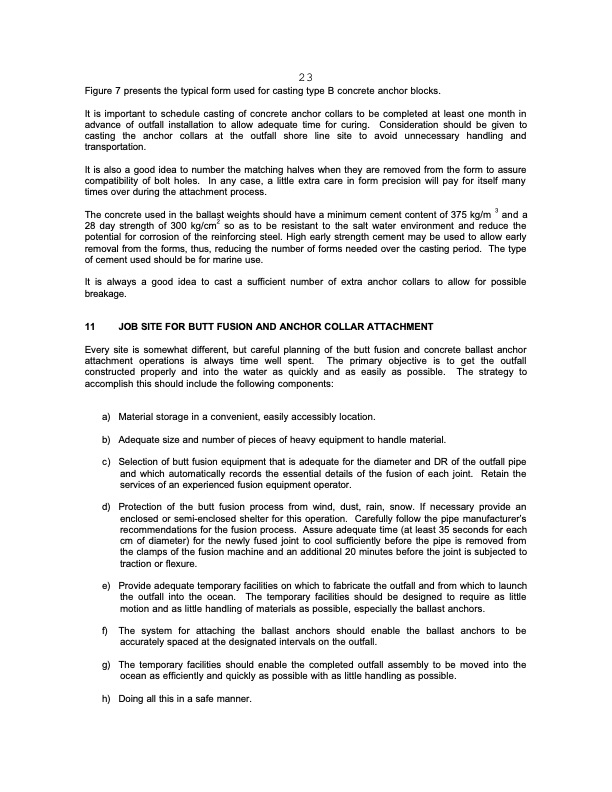
PDF Publication Title:
Text from PDF Page: 025
23 Figure 7 presents the typical form used for casting type B concrete anchor blocks. It is important to schedule casting of concrete anchor collars to be completed at least one month in advance of outfall installation to allow adequate time for curing. Consideration should be given to casting the anchor collars at the outfall shore line site to avoid unnecessary handling and transportation. It is also a good idea to number the matching halves when they are removed from the form to assure compatibility of bolt holes. In any case, a little extra care in form precision will pay for itself many times over during the attachment process. The concrete used in the ballast weights should have a minimum cement content of 375 kg/m 3 and a 28 day strength of 300 kg/cm2 so as to be resistant to the salt water environment and reduce the potential for corrosion of the reinforcing steel. High early strength cement may be used to allow early removal from the forms, thus, reducing the number of forms needed over the casting period. The type of cement used should be for marine use. It is always a good idea to cast a sufficient number of extra anchor collars to allow for possible breakage. 11 JOB SITE FOR BUTT FUSION AND ANCHOR COLLAR ATTACHMENT Every site is somewhat different, but careful planning of the butt fusion and concrete ballast anchor attachment operations is always time well spent. The primary objective is to get the outfall constructed properly and into the water as quickly and as easily as possible. The strategy to accomplish this should include the following components: a) Material storage in a convenient, easily accessibly location. b) Adequate size and number of pieces of heavy equipment to handle material. c) Selection of butt fusion equipment that is adequate for the diameter and DR of the outfall pipe and which automatically records the essential details of the fusion of each joint. Retain the services of an experienced fusion equipment operator. d) Protection of the butt fusion process from wind, dust, rain, snow. If necessary provide an enclosed or semi-enclosed shelter for this operation. Carefully follow the pipe manufacturer’s recommendations for the fusion process. Assure adequate time (at least 35 seconds for each cm of diameter) for the newly fused joint to cool sufficiently before the pipe is removed from the clamps of the fusion machine and an additional 20 minutes before the joint is subjected to traction or flexure. e) Provide adequate temporary facilities on which to fabricate the outfall and from which to launch the outfall into the ocean. The temporary facilities should be designed to require as little motion and as little handling of materials as possible, especially the ballast anchors. f) The system for attaching the ballast anchors should enable the ballast anchors to be accurately spaced at the designated intervals on the outfall. g) The temporary facilities should enable the completed outfall assembly to be moved into the ocean as efficiently and quickly as possible with as little handling as possible. h) Doing all this in a safe manner.PDF Image | SMALL DIAMETER (HDPE) SUBMARINE OUTFALLS

PDF Search Title:
SMALL DIAMETER (HDPE) SUBMARINE OUTFALLSOriginal File Name Searched:
OPSCEPISPUB0060_eng.PDFDIY PDF Search: Google It | Yahoo | Bing
Development of a solar powered Electric Ship The Electricship website originally started off as a project to develop a comprehensive renewable, affordable, modular electric ship... More Info
Modular Boat Hull Composite The case for a unsinkable, modular composite hybrid boat hull... More Info
MS Burgenstock Hybrid Electric Catamaran Lake Lucerne Unique shuttle servicing Lucerne to the Burgenstock Resort... More Info
Ground Power Unit GPU Powered by Lithium Ion Batteries The goal of the Ground Power Unit is to provide a readily accessible, modular, ready-to-power solution for remote power... More Info
| CONTACT TEL: 608-238-6001 Email: greg@electricship.com | RSS | AMP |